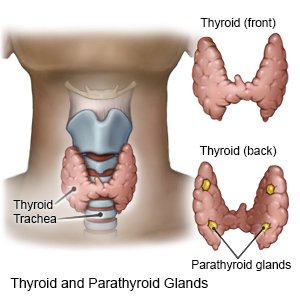Parathyroid Scintigraphy
Medically reviewed by Drugs.com. Last updated on Aug 4, 2025.
Parathyroid scintigraphy is a test used to look at parathyroid glands and tissues in your neck. The parathyroid glands maintain calcium and phosphate levels in your body. Sometimes the parathyroid glands are overactive. The test may show an adenoma (non-cancerous tumor) that is preventing the parathyroid glands from working properly. Parathyroid scintigraphy helps healthcare providers diagnose your condition and plan your treatment.
 |
WHILE YOU ARE HERE:
Before the test:
Informed consent
is a legal document that explains the tests, treatments, or procedures that you may need. Informed consent means you understand what will be done and can make decisions about what you want. You give your permission when you sign the consent form. You can have someone sign this form for you if you are not able to sign it. You have the right to understand your medical care in words you know. Before you sign the consent form, understand the risks and benefits of what will be done. Make sure all your questions are answered.
Related medications
During the test:
Parathyroid scintigraphy can take 3 hours or more as the radioactive medicine moves through your body. The test is done as a series of pictures. You will need to stay still while the pictures are taken.
- An IV will be put in a vein. You will be given radioactive medicine through the IV. The medicine may also be given as a pill. The medicine helps the parathyroid glands show up better in the pictures.
- You may receive 2 kinds of radioactive medicines. Expect the test to take more time if 2 medicines are used.
- Pictures of your neck and chest are taken with each dose of radioactive medicine.
After the test:
- Drink liquids as directed. You may need to drink more liquids than usual. Ask your healthcare provider how much liquid to drink each day and which liquids are best for you. Liquids will help flush the radioactive medicine out of your body.
- You may not be able to breastfeed after this test. Ask healthcare providers how long you must stop breastfeeding.
RISKS:
The radiopharmaceutical used during parathyroid scintigraphy contains radiation. Radiation increases the risk of miscarriage and can affect the development of an unborn baby. The results of your test may not be clear. This can happen when the radiopharmaceutical does not show up in the abnormal tissue. The number and location of the abnormal glands or thyroid problems may also cause unclear results. You may need more tests to help diagnose or treat your parathyroid condition.
CARE AGREEMENT:
You have the right to help plan your care. Learn about your health condition and how it may be treated. Discuss treatment options with your healthcare providers to decide what care you want to receive. You always have the right to refuse treatment.© Copyright Merative 2025 Information is for End User's use only and may not be sold, redistributed or otherwise used for commercial purposes.
The above information is an educational aid only. It is not intended as medical advice for individual conditions or treatments. Talk to your doctor, nurse or pharmacist before following any medical regimen to see if it is safe and effective for you.
Further information
Always consult your healthcare provider to ensure the information displayed on this page applies to your personal circumstances.
